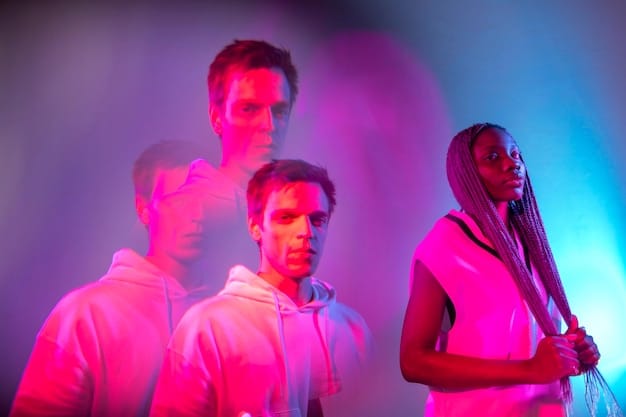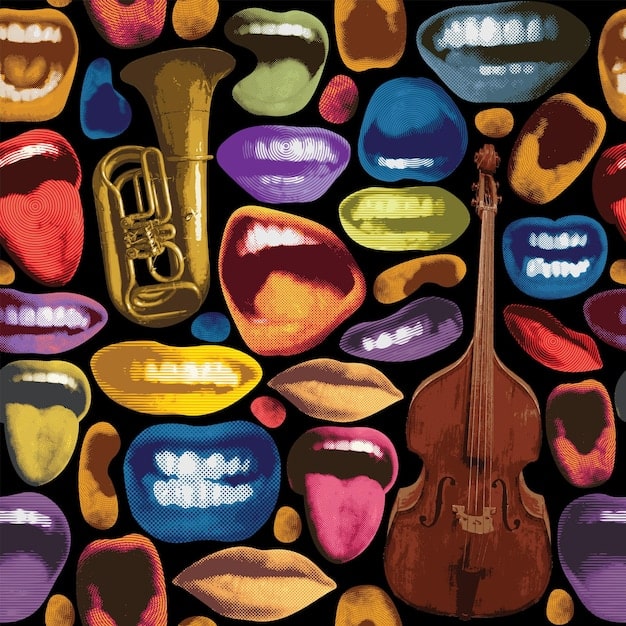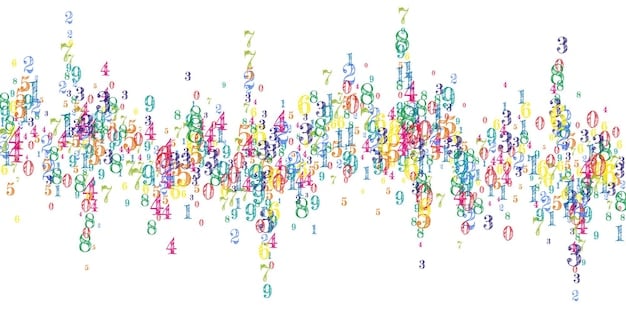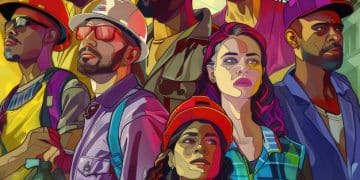The Future of Hip Hop: Emerging Artists & Tomorrow’s Sound

The future of hip hop is being definitively sculpted by emerging artists, who are redefining its sonic landscape and lyrical narratives through innovative sounds and diverse cultural influences, ensuring the genre’s continued evolution and global impact.
The landscape of music is ever-evolving, and few genres embody this fluidity quite like hip hop. As we look towards tomorrow, it’s clear that The Future of Hip Hop: How Emerging Artists Are Shaping the Sound of Tomorrow isn’t just a hypothetical; it’s a living, breathing transformation happening right before our ears. These artists, unburdened by past conventions, are pushing creative boundaries, blending genres, and crafting narratives that resonate deeply with a new generation.
The Evolution of Hip Hop: A Brief Look Back
Hip hop began its journey as a raw, unfiltered voice from the streets of the Bronx, evolving from simple breakbeats and lyrical storytelling to become a global phenomenon. Its roots are deeply embedded in community, struggle, and expression, offering a powerful platform for a generation often overlooked.
Over the decades, hip hop has undergone countless transformations. From the golden era’s intricate lyricism to the gangsta rap narratives, the conscious rap movement, and the rise of trap music, each phase reflected societal shifts and technological advancements. What started as party music expanded into a complex tapestry of social commentary, personal introspection, and bravado.
Pioneering Sounds and Influences
Early innovators laid the groundwork for hip hop’s foundational elements, experimenting with turntablism, rhyming, and beat production. These pioneers established the core principles that future artists would build upon, creating a lineage of continuous innovation.
- Grandmaster Flash: Mastered the art of scratching and mixing, pioneering DJ techniques.
- Kool Herc: Credited with isolating the “break” in records, forming the basis of hip hop beats.
- Sugarhill Gang: Released “Rapper’s Delight,” bringing hip hop to a mainstream audience.
- Run-DMC: Fused rock with hip hop, broadening its appeal and commercial viability.
The genre’s ability to absorb and reinterpret cultural influences has been key to its resilience and growth. From jazz and soul samples to reggae riddims and electronic beats, hip hop is a formidable melting pot of sounds, making it a dynamic and unpredictable art form.
Understanding this historical context is vital when examining the current trajectory of hip hop. It shows a genre always in motion, constantly reinventing itself while honoring its foundational elements, setting the stage for today’s emerging talents to forge new paths.
Genre Fusion: Breaking Down Traditional Barriers
One of the most defining characteristics of today’s hip hop landscape is its fearless approach to genre fusion. Emerging artists are no longer content with staying within the confines of established hip hop subgenres; instead, they are weaving together disparate musical threads to create entirely new tapestries of sound.
This blending of genres is not merely experimental; it is often an organic reflection of the artists’ diverse musical diets and influences. They grew up in an era of digital access, where music from across the globe and time periods is readily available, fostering a broad and eclectic taste palette.
The Rise of Cross-Genre Collaborations
Collaborations with artists from different musical backgrounds are becoming increasingly common, leading to groundbreaking tracks that defy easy categorization. These partnerships often yield unexpected sonic outcomes, challenging listeners’ preconceived notions of what hip hop can be.
- R&B and Soul Infusions: Blending smooth vocals and intricate melodies with rap, creating more emotional and layered tracks.
- Electronic and Lo-Fi Beats: Incorporating ambient sounds, synth-heavy production, and unconventional rhythms, producing atmospheric soundscapes.
- Alternative Rock and Punk Influences: Injecting raw energy, distorted guitars, and defiant attitudes, challenging the melodic norms of hip hop.
- Global Sounds: Integrating rhythms, instruments, and vocal styles from Afrobeat, Latin music, and Asian traditions, showcasing a truly global sensibility.
The push to innovate extends beyond just sonic elements. Lyrical themes are also expanding, moving past conventional bravado to embrace vulnerability, social commentary, and deeply personal narratives. This allows for a richer, more nuanced storytelling that appeals to a broader audience base.

This willingness to experiment is reshaping audience expectations and expanding hip hop’s appeal far beyond its traditional listener base. It transforms the genre into a truly universal language, capable of communicating with diverse cultures and age groups, highlighting its infinite adaptability.
The Power of Digital Platforms and Independent Artists
The digital age has ushered in an unprecedented era of accessibility and democratization for music creation and distribution. For emerging hip hop artists, platforms like SoundCloud, YouTube, TikTok, and independent streaming services are not just tools; they are vital arteries for building careers and connecting directly with fans.
Gone are the days when a major record label was the sole gatekeeper to success. Today, an artist with a laptop, a microphone, and a solid internet connection can produce, distribute, and promote their music to a global audience, bypassing traditional industry structures entirely.
This shift empowers artists to maintain creative control and ownership over their work, fostering an environment where authenticity thrives. They can experiment freely, release music on their own schedule, and cultivate a unique brand identity without external pressures.
Direct-to-Fan Engagement and Community Building
Digital platforms facilitate a direct line of communication between artists and their audience. This immediate feedback loop allows artists to gauge their sound’s impact, respond to fan preferences, and build a dedicated community around their artistry.
- SoundCloud: A breeding ground for experimental sounds and a launchpad for many viral hits, allowing artists to upload tracks easily.
- YouTube: Essential for visual storytelling through music videos, live performances, and behind-the-scenes content.
- TikTok: A powerful engine for virality, where snippets of songs can explode into global sensations overnight, driving discovery.
- Bandcamp: Supports artists by allowing them to set their own prices for music and merchandise, often giving a larger cut to the artist.
The financial independence offered by these platforms is also significant. Through direct sales, crowdfunding, and leveraging content monetization features, artists can sustain their careers and invest in their craft without relying on traditional advances that come with restrictive contracts.
This independent spirit is fundamentally altering the industry’s power dynamics, giving more leverage to creators. It also encourages a constant flow of new talent and innovative sounds, ensuring the genre remains fresh and responsive to contemporary culture, defining tomorrow’s sound in real-time.
Lyricism and Storytelling: New Narratives and Perspectives
While the beats and production continue to evolve, the heart of hip hop has always been its lyricism and storytelling. Emerging artists are pushing the boundaries of textual expression, offering narratives that are more diverse, introspective, and socially conscious than ever before.
The content themes in modern hip hop are expanding beyond well-trodden paths of bravado and materialism. Artists are increasingly using their platforms to explore mental health struggles, identity, systemic injustices, and deeply personal experiences, resonating with a generation hungry for authenticity.
This shift indicates a growing maturity within the genre, demonstrating its capacity for profound social commentary and emotional vulnerability. Artists are not afraid to be raw and honest, exposing their inner worlds and the complexities of modern life, which in turn fosters deeper connections with listeners.
Authenticity and Personal Experience
Many emerging artists prioritize authenticity, sharing their stories with an unflinching honesty that cuts through the noise. This commitment to raw truth is a significant factor in their ability to connect with diverse audiences globally.
- Mental Health Awareness: Openly discussing anxiety, depression, and self-care, destigmatizing these topics.
- Social and Political Commentary: Addressing issues like racial injustice, economic inequality, and environmental concerns with articulate passion.
- Cultural Identity: Exploring heritage, migration, and the complexities of belonging in a multicultural world.
- Vulnerability and Imperfection: Sharing personal failures, doubts, and emotional struggles, promoting relatability.
The lyrical dexterity displayed by these artists is often a blend of intricate wordplay, inventive metaphors, and compelling narrative arcs. They use their voices to paint vivid pictures, inviting listeners into their worlds and challenging them to reconsider their own perspectives.
This rich tapestry of narratives ensures that hip hop remains a powerful cultural mirror, reflecting the complexities and nuances of contemporary society. It’s a testament to the genre’s enduring power as a vehicle for storytelling and a platform for unheard voices to truly shine.
Global Influence and Local Flavors
Hip hop has long been a global phenomenon, but emerging artists are now amplifying this reach by infusing local flavors and languages into the genre, creating a truly diverse and vibrant musical tapestry. This fusion allows hip hop to maintain its global appeal while celebrating specific cultural identities.
From the streets of Lagos to the bustling cities of Seoul and the vibrant communities of São Paulo, artists are adapting hip hop’s core elements – rhythm, rhyme, and storytelling – to reflect their unique environments. This localization process is critical for the genre’s continued evolution.
The internet and social media act as conduits, allowing these localized sounds to transcend geographical boundaries and find new audiences. A track from Ghana can go viral in the US, and a UK drill track can influence producers in Canada, showcasing a truly interconnected musical world.
Diverse Accents and Regional Dialects
The inclusion of various languages, accents, and regional slang adds a layer of richness and authenticity to the music. It allows artists to express themselves more genuinely and connect with their immediate communities while still appealing to a global audience.
- Afrobeats-infused Hip Hop: Incorporating West African rhythms and melodies, creating infectious, danceable tracks.
- UK Drill and Grime: Known for their distinct lyrical flows, gritty narratives, and unique sonic textures that resonate globally.
- Latin Trap and Reggaeton: Blending Spanish lyrics with trap beats and reggaeton rhythms, creating chart-topping hits across continents.
- K-Hip Hop: Merging Western hip hop influences with Korean language and pop sensibilities, gaining traction worldwide.
This global cross-pollination is not a one-way street. As international artists gain traction, they, in turn, influence Western artists, creating a cyclical exchange of ideas and sounds. This constant flow of inspiration ensures that hip hop remains a dynamic and ever-changing genre.

The future of hip hop is inherently multicultural. It’s a genre that thrives on diversity, drawing strength from countless local expressions that collectively contribute to its global identity, cementing its status as an truly international art form adaptable to any context or culture.
Technological Advancements in Music Production
Technology has always played a pivotal role in the evolution of hip hop, from early sampling techniques to modern digital audio workstations (DAWs). Today, emerging artists are leveraging cutting-edge advancements in music production to push sound boundaries further, crafting intricate soundscapes.
The accessibility of powerful production software and hardware has democratized beat-making, allowing anyone with a computer and a passion for music to create professional-grade tracks. This means more diverse voices and innovative sounds are entering the market than ever before.
Artificial intelligence (AI) is also beginning to make its mark, from AI-powered mastering tools to generative music algorithms. While still in its infancy in mainstream production, AI promises to offer new creative avenues and efficiencies for ambitious artists and producers.
Tools and Techniques Redefining Sound
Modern production techniques allow for immense creativity, enabling artists to sculpt sounds with precision and experiment with complex arrangements. The toolkit available today is vast, supporting limitless sonic exploration.
- Advanced DAWs (e.g., Ableton Live, FL Studio, Logic Pro): Offer comprehensive environments for sequencing, sampling, mixing, and mastering.
- Virtual Instruments and Plugins: Provide access to an infinite array of sounds, from realistic orchestral arrangements to futuristic synth textures.
- Cloud Collaboration Tools: Enable producers and artists from different locations to work on the same project in real-time, fostering global teamwork.
- Interactive Mixing and Mastering: Automate and enhance the final sound design, giving tracks a polished, radio-ready quality.
Beyond the technical aspects, these tools empower artists to become complete creative entities, often acting as their own producers, engineers, and even marketers. This holistic approach ensures their artistic vision remains intact from conception to final release.
The ongoing synergy between technology and creativity promises an exciting future for hip hop sound design. As new tools emerge, artists will undoubtedly find innovative ways to employ them, ensuring the genre’s sonic evolution continues at a rapid pace, always pushing the limits of audio possibilities.
The Business of Hip Hop: Innovation in Monetization
Beyond sound and lyricism, emerging hip hop artists are also innovating heavily in the business aspect of their careers. The traditional revenue streams of album sales and touring are being supplemented, and sometimes overshadowed, by new monetization strategies that leverage the digital ecosystem and direct fan engagement.
Smart artists are recognizing that their brand is their most valuable asset, transforming themselves into multi-faceted entrepreneurs. They are diversifying their income, reducing reliance on conventional models, and building sustainable careers on their own terms. This shift is giving artists more control over their financial destinies.
The entrepreneurial spirit within the hip hop community has always been strong, but the digital age has provided unprecedented tools for artists to capitalize on their creativity directly, fostering a new generation of artist-entrepreneurs who are reshaping the industry’s economic models.
Diversified Revenue Streams
Today’s artists are tapping into a wider array of income opportunities, moving beyond just music sales and live performances. This diversification provides financial stability and allows for greater creative freedom.
- Merchandise and Brand Partnerships: Designing and selling clothing lines, accessories, and collaborating with brands for sponsored content.
- Subscription Services and Fan Clubs: Offering exclusive content, early access, and direct interaction for a recurring fee.
- NFTs and Web3 Technologies: Exploring blockchain-based assets for unique fan experiences, digital collectibles, and fractional ownership of music.
- Content Creation (Podcasts, Gaming, Streaming): Expanding their presence beyond music into other digital entertainment formats.
The emphasis is increasingly on building a comprehensive ecosystem around the artist’s brand, where music is just one component of a larger creative and commercial enterprise. This holistic approach ensures longevity and multiple touchpoints for fan engagement.
By taking charge of their business models, emerging artists are not only securing their own financial future but are also providing a blueprint for the next generation. They are proving that creativity and commerce can coexist harmoniously, setting new standards for artistic independence and financial acumen in music.
| Key Aspect | Brief Description |
|---|---|
| 🎶 Genre Fusion | Emerging artists blend diverse sounds (R&B, electronic, global) breaking traditional hip hop boundaries. |
| 💻 Digital Empowerment | Platforms (SoundCloud, TikTok) enable independent artists to reach global audiences and maintain control. |
| ✍️ Evolving Narratives | Lyrical content explores mental health, identity, and social issues with greater authenticity and depth. |
| 🌍 Global & Local | Hip hop integrates local languages and cultural flavors, expanding its international appeal and diversity. |
Frequently asked questions
▼
Emerging hip hop artists are transforming the genre by fearlessly blending it with diverse musical styles such as R&B, electronic, alternative rock, and global sounds like Afrobeats. This constant experimentation with new sonic textures, unconventional rhythms, and innovative production techniques fundamentally reshapes its traditional sound, pushing creative boundaries far beyond previous conventions. They prioritize fresh, unique sounds.
▼
Digital platforms like SoundCloud, YouTube, and TikTok are pivotal for emerging artists. They provide accessible avenues for creating, distributing, and promoting music independently, bypassing traditional gatekeepers. These platforms facilitate direct fan engagement, enabling artists to build communities, gain immediate feedback, and monetize their work without relying solely on record labels, fostering unparalleled artistic freedom and reach.
▼
Yes, hip hop lyrical themes are evolving significantly beyond past conventions. Emerging artists are increasingly delving into more personal and introspective narratives, openly discussing mental health, identity, and societal injustices. This shift towards vulnerability, authenticity, and profound social commentary allows for deeper connections with listeners, offering a richer, more nuanced exploration of contemporary experiences and complex human emotions.
▼
Hip hop’s global influence is expanding by integrating local languages, regional dialects, and cultural flavors from around the world. Artists from Africa, Asia, and Latin America are infusing their unique traditions into the genre, creating vibrant new subgenres like Afrobeats-infused hip hop, UK Drill, and Latin Trap. Digital media then facilitates this cross-cultural exchange, making these localized sounds globally accessible.
▼
Emerging artists are employing diverse monetization strategies beyond traditional album sales and touring. These include direct-to-fan sales, robust merchandise lines, brand partnerships, and exclusive subscription services offering unique fan content. Many are also exploring Web3 technologies like NFTs for digital collectibles and fractional ownership, ensuring sustainable careers by diversifying their income streams and building strong entrepreneurial brands in the evolving digital economy.
Conclusion
The current trajectory of hip hop is a testament to its inherent adaptability and enduring power as a cultural force. Emerging artists are not merely following in the footsteps of their predecessors; they are actively forging new paths, redefining the genre through fearless genre fusion, independent digital distribution, and compelling, authentic narratives. Their embrace of global influences and innovative business models ensures that hip hop remains at the vanguard of musical and cultural evolution. As we observe these shifts, it becomes clear that the future of hip hop is vibrant, diverse, and perpetually innovative, promising a sound world rich with unexpected artistry and profound storytelling for decades to come.





